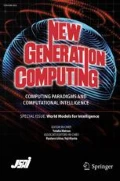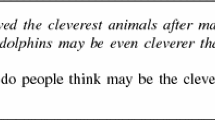Abstract
This paper demonstrates the capabilities offoidl, an inductive logic programming (ILP) system whose distinguishing characteristics are the ability to produce first-order decision lists, the use of an output completeness assumption as a substitute for negative examples, and the use originally motivated by the problem of learning to generate the past tense of English verbs; however, this paper demonstrates its superior performance on two different sets of benchmark ILP problems. Tests on the finite element mesh design problem show thatfoidl’s decision lists enable it to produce generally more accurate results than a range of methods previously applied to this problem. Tests with a selection of list-processing problems from Bratko’s introductory Prolog text demonstrate that the combination of implicit negatives and intensionality allowfoidl to learn correct programs from far fewer examples thanfoil.
Similar content being viewed by others
References
Aha, D. W., Lapointe, S., Ling, C. X., and Matwin, S., “Learning Recursive Relations with Randomly Selected Small Training Sets”, inProceedings of the Eleventh International Conference on Machine Learning, New Brunswick, NJ, pp.12–18, 1994.
Bergadano F. and Gunetti, D., “An Interactive System to Learn Functional Logic Programs”, inProceedings of the Thirteenth International Joint Conference on Artificial Intelligence, Chambery, France, pp. 1044–1049, 1993.
Bergadano, F., Gunetti, D., and Trinchero, U., “The Difficulties of Learning Logic Programs with Cut,”Journal of Artificial Intelligence Research, 1, pp. 91–107, 1993.
Bloom, P., “Overview: Controversies in Language Acquisition,” inLanguage Acquisition: Core Readings (Bloom, P., ed.), MIT Press, Cambridge, MA pp. 5–48, 1994.
Bratko, I.,Prolog Programming for Artificial Intelligence, Addison Wesley, Reading, MA, 1990.
Califf, M. E. and Mooney, R., “Applying ILP-Based Techniques to Natural Language Information Extraction: An Experiment in Relational Learning”, inWorking Notes of the IJCAI-97 Workshop on Frontiers in Inductive Logic Programming, 1997.
Cameron-Jones, R. M. and Quinlan, J. R., “Avoiding Pitfalls When Learning Recursive Theories”, inProceedings of the Thirteenth International Joint Conference on Artificial Intelligence, Chambery, France, pp. 1050–1055, 1993.
Cameron-Jones, R. M. and Quinlan, J. R., “Efficient Top-down Induction of Logic Programs,”SIGART Bulletin, 5, 1, pp. 33–42, 1994.
Clark, P. and Niblett, T., “The CN2 Induction Algorithm,”Machine Learning, 3, pp. 261–284, 1989.
Cohen, W. W., “Pac-Learning a Restricted Class of Recursive Logic Programs,” inProceedings of the Eleventh National Conference on Artificial Intelligence, Washington, D. C., pp. 86–92, 1993.
De Raedt, L. and Bruynooghe, M., “A Theory of Clausal Discovery”, inProceedings of the Thirteenth International Joint Conference on Artificial Intelligence, Chambery, France, pp. 1058–1063, 1993.
Dolsak, B. and Muggleton, S., “The Application of Inductive Logic Programming to Finite-Element Mesh Design,” inInductive Logic Programming (Muggleton, S., ed.), Academic Press, New York, pp. 453–472, 1992.
Estlin, T. A. and Mooney, R., “Learning to Improve Both Efficiency and Quality of Planning” inProceedings of the Fifteenth International Joint Conference on Artificial Intelligence, pp. 1227–1232, 1997.
Inuzaka, N., Kamo, M., Ishii, N., Seki, H., and Itoh, H., “Top-down Induction of Logic Programs from Incomplete Samples,” inProceedings of the Sixth International Workshop on Inductive Logic Programming, pp. 119–136, 1996.
Jorge, A. and Brazdil, P., “Architecture for Iterative Learning of Recursive Definitions,” inAdvances in Inductive Logic Programming (De Raedt, L., ed.), IOS Press, Amsterdam, 1996.
Karalič, A., “First Order Regression,”Ph. D. thesis, University of Ljubljana, Slovenia, 1995.
Lapointe, S. and Matwin, S., “Sub-Unification: A Tool for Efficient Induction of Recursive Programs,” inProceedings of the Ninth International Conference on Machine Learning, Aberdeen, Scotland, pp. 273–281, 1992.
Lavrač, N. and Džeroski, S.,Inductive Logic Programming: Techniques and Applications, Ellis Horwood, 1994.
Mooney, R. J., “Inductive Logic Programming for Natural-Language Processing,” inProceedings of the Sixth International Workshop on Inductive Logic Programming, pp. 205–224, 1996.
Mooney, R. J. and Califf, M. E., “Induction of First-Order Decision Lists: Results on Learning the Past Tense of English Verbs,”Journal of Artificial Intelligence Research, 3, pp. 1–24, 1995.
Muggleton, S. and Feng, C., “Efficient Induction of Logic Programs,” inProceedings of the First Conference on Algorithmic Learning Theory, Tokyo, Japan, Ohmsha, 1990.
Muggleton, S. H. (ed.),Inductive Logic Programming, Academic Press, New York, NY, 1992.
Muggleton, S., “Inverse Entailment and Progol,”New Generation Computing, 13, pp. 245–286, 1995.
Quinlan, J. R., “Determinate Literals in Inductive Logic Programming”, inProceedings of the Eighth International Workshop on Machine Learning, Evanston, IL, 1991.
Quinlan, J. R., “Learning First-Order Definitions of Functions,”Journal of Artificial Intelligence Research, 5, pp. 139–161, 1996.
Quinlan, J. R. and Cameron-Jones, R. M., “FOIL: A Midterm Report,” inProceedings of the European Conference on Machine Learning, Vienna, pp. 3–20, 1993.
Quinlan, J., “Learning Logical Definitions from Relations,”Machine Learning, 5, 3, pp. 239–266, 1990.
Richards, B. L. and Mooney, R. J., “Automated Refinement of First-Order Horn-Clause Domain Theories,”Machine Learning, 19, 2, pp. 95–131, 1995.
Rivest, R. L., “Learning Decision Lists,”Machine Learning, 2, 3, pp. 229–246, 1987.
Rumelhart, D. E. and McClelland, J., “On Learning the Past Tense of English Verbs,” inParallel Distributed Processing, Vol. II (Rumelhart, D. E. and McClelland, J. L., eds.), MIT Press, Cambridge, MA, pp. 216–271, 1986.
Webb, G. I. and Brkič, N., “Learning Decision Lists by Prepending Inferred Rules”, inProceedings of the Australian Workshop on Machine Learning and Hybrid Systems, Melbourne, Australia, pp. 6–10, 1993.
Zelle, J. M., “Using Inductive Logic Programming to Automate the Construction of Natural Language Parsers,”Ph. D. thesis, University of Texas, Austin, TX, 1995. Also appears asTechnical Report, AI 96-249, Artificial Intelligence Laboratory.
Zelle, J. M. and Mooney, R. J., “Combining FOIL and EBG to Speed-up Logic Programs,” inProceedings of the Thirteenth International Joint Conference on Artificial Intelligence, Chambery, France, pp. 1106–1111, 1993.
Zelle, J. M. and Mooney, R. J., “Combining Top-down and Bottom-up Methods in Inductive Logic Programming,” inProceedings of the Eleventh International Conference on Machine Learning, New Brunswick, NJ, pp. 343–351, 1994.
Zelle, J. M. and Mooney, R. J., “Learning to Parse Database Queries Using Inductive Logic Programming,” inProceedings of the Thirteenth National Conference on Artificial Intelligence, Portland, OR, 1996.
Author information
Authors and Affiliations
Additional information
This research was supported by a fellowship from AT&T awarded to the first author and by the National Science Foundation under grant IRI-9310819.
Mary Elaine Califf: She is currently pursuing her doctorate in Computer Science at the University of Texas at Austin where she is supported by a fellowship from AT&T. Her research interests include natural language understanding, particularly using machine learning methods to build practical natural language understanding systems such as information extraction systems, and inductive logic programming.
Raymond Joseph Mooney: He is an Associate Professor of Computer Sciences at the University of Texas at Austin. He recerived his Ph.D. in Computer Science from the University of Illinois at Urbana-Champaign in 1988. His current research interests include applying machine to natural language understanding, inductive logic programming, knowledge-base and theory refinement, learning for planning, and learning for recommender systems. He serves on the editorial boards of the journalNew Generation Computing, theMachine Learning journal, theJournal of Artificial Intelligence Research, and the journalApplied Intelligence.
About this article
Cite this article
Califf, M.E., Mooney, R.J. Advantages of decision lists and implicit negatives in Inductive Logic Programming. New Gener Comput 16, 263–281 (1998). https://doi.org/10.1007/BF03037482
Received:
Revised:
Issue Date:
DOI: https://doi.org/10.1007/BF03037482




